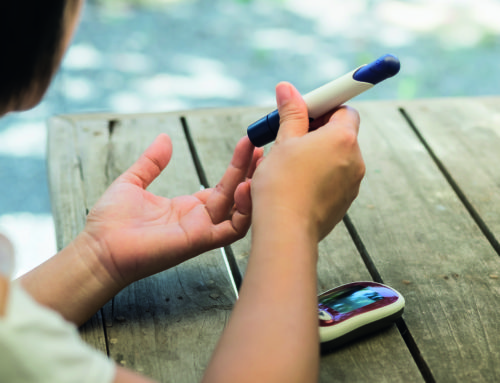Around 70 per cent of people will experience some form of eczema in their life (1), with around 70-to-90 per cent of cases occurring in children before five years of age (2), and there being a high incidence of on-set in the first year of life. When it comes to managing the symptoms of baby eczema, emollients are the first line of defence. Deborah Wyatt, Patient Engagement Specialist at talkhealth, explores their role further; from securing the appropriate choice and advising on application, to accessing additional channels of support.
The purpose of emollients is to soothe and hydrate the skin by occluding the skin barrier, which prevents water loss (trans-epidermal water loss or TEWL). Plus, medical emollients are fragrance-free and detergent-free.
Some emollients (humectants) also have natural moisturising properties which helps aid skin repair, and emollients with ceramides (also referred to as fats or lipids) replace fats around the skin.
Well-moisturised skin is crucial to the management of eczema as the emollient waterproof protective layer will help repair the faulty skin barrier.
Bathing and Washing Infants
Emollient bath oils and other emollient wash products clean skin without the damaging effects of soaps and detergents.
When washing with emollients or wash products, recommend that the parent covers the baby’s body with a leave-on emollient or wash product before getting into the bath and then soak off in lukewarm water. Using an emollient or wash product in the bath is an essential part of Complete Emollient Therapy, as described later, as it helps with skin hydration. Recommend that the parent applies leave-on emollients immediately after they bathe their baby to lock moisture into the skin.
Recommending the Right Emollient
There are a wide range of emollient treatments for babies with eczema that are available in different formulations. Finding the right emollient will vary from person-to-person and often it is down to trial and error.
• Lotions – are cooling, spread and absorb easily, but contain more water than oil-based emollients, so don’t necessarily occlude the skin barrier well for babies with very dry skin
• Creams – are easy-to-use and absorb well, but need to be applied every three-to-four hours
• Humectant creams – are the same consistency as creams, but contain additional natural moisturising ingredients which help skin cells retain water, so these have a double action. They have a longer-lasting effect on the skin than creams and gels of around six-to-eight hours
• Gels – are light and non-greasy, despite a high oil content, so need to be applied to the skin every three-to-four hours. They can leave globules on the skin
• Ointments – leave a thick film on the skin to prevent water loss and help to repair the skin barrier. They contain less water, but are greasy and can be messy to use. Some parents may prefer only to use these at night
• Sprays – are ointment-based and give even body coverage, but can make the floor slippery so always recommend standing on a towel / mat or apply standing in the bath on a bathmat
• Note – aqueous cream shouldn’t be used for babies with eczema as a leave-on treatment because it contains sodium lauryl sulphate which can cause irritation and make eczema worse in some babies and children (3)
Some Emollients Contain Added Ingredients to Help with the Symptoms of Eczema
• Antimicrobials – have antiseptics added to both wash products and leave-on emollients, which helps prevent infection
• Lauromacrogols and oatmeal – these ingredients have anti-itch properties
• Ceramides – restore the balance of fats around skin cells to help the functioning of the skin barrier
Application of Emollients – How Much and How Often?
Correct application and using the right amount of emollient is important. Emollients should never be rubbed into the skin as this could trigger itching, block hair follicles, and create more heat in the skin. Instead, advise parents to liberally apply the emollient by dotting it onto the skin, and then use long and gentle downward strokes, smoothing the emollient into the skin, to leave a thin film.
Emollients should be applied all over the baby’s skin at least twice a day as a minimum, with additional applications whenever the skin appears dry and itchy.
A baby can have emollients applied at every nappy change and if they are scratching and show signs of dry skin.
Emollients should be recommended to use continually every day, even when the eczema appears clear, as regular use prevents eczema flare-ups.
Complete Emollient Therapy
Complete Emollient Therapy (CET) is a way of keeping the skin moisturised by using a combination of products, including an emollient-based cleanser or soap substitute, with regular application of creams or ointments throughout the day and at bedtime. Having a CET regime helps to support the skin’s natural barrier, keeping moisture in and irritants out.
For babies with atopic eczema, it’s important to explain to parents that everything that touches their baby’s skin should be emollient-based and all soaps and detergents need to be replaced with an emollient wash, bath and shower products.
Two-in-One and Three-in-One Products
It might be appropriate to consider either a two-in-one or three-in-one product. A two-in-one product can be used as a wash / soap substitute and also as a leave-on emollient.
A three-in-one can be added to bath water, used as a wash product / soap substitute and a leave-on emollient.
Many emollients can be used as three-in-one products, with the exception of 50 / 50 white soft paraffin / liquid paraffin products.
Emollient Choice
Discuss the options available to find out what the parent prefers e.g. lotion, cream, gel etc. Some parents may prefer to use one emollient for both washing and moisturising the skin, while others might opt for a selection of different formulas e.g. a bath oil and / or wash, a cream for daytime and an ointment for night.
Factors to consider when recommending an emollient include where the baby will be during the day, e.g. at home or staying with a carer? Will they be at nursery? Does the parent prefer to apply something lighter on the skin during the day rather than heavier emollient options? Does their baby appear irritated by thick creams?
No two emollients or babies are the same and everyone will have different needs, so what suits one baby, may not suit another.
NICE Guidance on Emollients for the Treatment of Atopic Eczema in Children Under 12 Years States:
‘Healthcare professionals should offer children with atopic eczema a choice of unperfumed emollients to use every day for moisturising, washing and bathing. This should be suited to the child’s needs and preferences and may include a combination of products or one product for all purposes.’ (4)
Cradle Cap (Seborrheic Dermatitis)
Cradle cap is often confused with eczema but is much less red and scaly and generally clears up by the time a baby is eight months old. It appears on the scalp, sides of the nose, eyelids and eyebrows, and behind the ears.
If a parent is worried about cradle cap, recommend washing their baby’s hair once-a-day with a mild, tear-free baby shampoo and to gently remove the scales with a soft brush or a toothbrush.
It can also help to suggest that they apply a small amount of mineral oil or petroleum jelly to their baby’s head, let it soak for a few minutes up to several hours, depending on the severity, and then gently brush, followed by shampooing their baby’s hair.
Emollient Health and Safety
Some extra tips to recommend to parents include:
• Emollients and stinging – if your baby’s skin is very dry and hot to the touch, keep your emollient in the fridge so it has a cooling effect on the skin when applied
• Safety in the bath – emollients may cause the bath or shower to become slippery, so a bathmat is always good to recommend to parents. There is also a fire hazard with paraffin-based emollients so when in contact with or near naked flames, warn parents to be careful as paraffin-soaked clothing / bandages are at risk of igniting
Additional Support
In the UK, NHS guidance for the routine prescribing of some products has changed.
Prescriptions for silk clothing and emollients to treat eczema will now not be routinely prescribed. A recent talkhealth survey revealed that 68 per cent of 439 people surveyed were currently receiving bath or shower additives on prescription, and 56 per cent said they were not aware of the change in prescribing guidance. (5)
The same survey found that 87 per cent would find it helpful if their GP offered a support programme written specifically to help them manage their child’s eczema.
Based on this research and having talked to 76 healthcare professionals and examined the gaps in NHS service delivery, talkhealth has created a free online support programme called myeczemachild. Written by medical experts it provides evidence-based, unbiased guidance and information for parents around self-care.
talkhealth support programmes are already available in GP surgeries around the UK for healthcare professionals to offer to their patients.
To find out more about how talkhealth are supporting medical professionals with information they can give to their patients, visit talkhealth medical at www.talkhealthmedical.com.
References
1. https://nationaleczema.org/eczema/children
2. https://cks.nice.org.uk/eczema-atopic
3. http://www.mhra.gov.uk/home/groups/s-par/documents/websiteresources/con512958.pdf
4. https://www.nice.org.uk/guidance/qs44/resources/atopic-eczema-in-under-12s-pdf2098666709701
5. talkhealthpartnership.com
About the Author
Deborah Wyatt is a Patient Engagement Specialist; partnering with healthcare and pharmacy to provide effective patient programmes and solutions.
Such a lack of support back in 2000 prompted the idea of talkhealth, following the birth of Deborah’s daughter with a chronic eczema condition. The talkhealth team are very aware of how time-consuming it is piecing together all the disparate information that is available across the internet, plus most importantly understanding its trustworthiness.
Secondly, they also understand the wish for people to be able to easily communicate directly with others in a similar position. Chronic health conditions can be very alienating and there is only so much you can repeatedly discuss with family and friends. Talking openly with others who fully understand health issues is a very important part of the talkhealth community experience.







